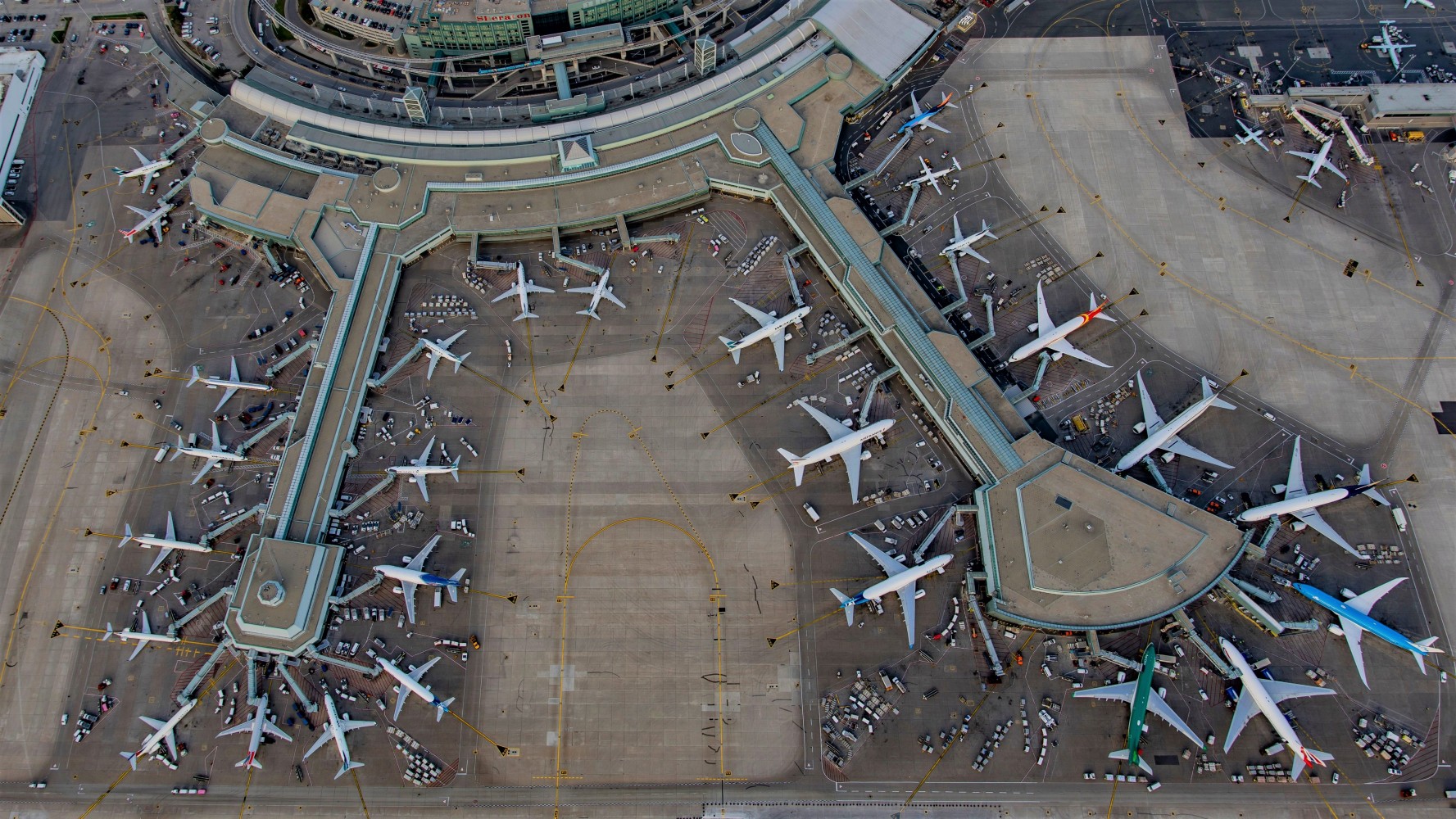
Pearson Airport has been dining out on Mississauga for years, could COVID-19 finally change that?
Mississauga and Pearson Airport are joined at the hip.
The City provides a range of services, including paramedics and infrastructure, even subsidizing the buses that serve the airport by an average of 53 percent per ride.
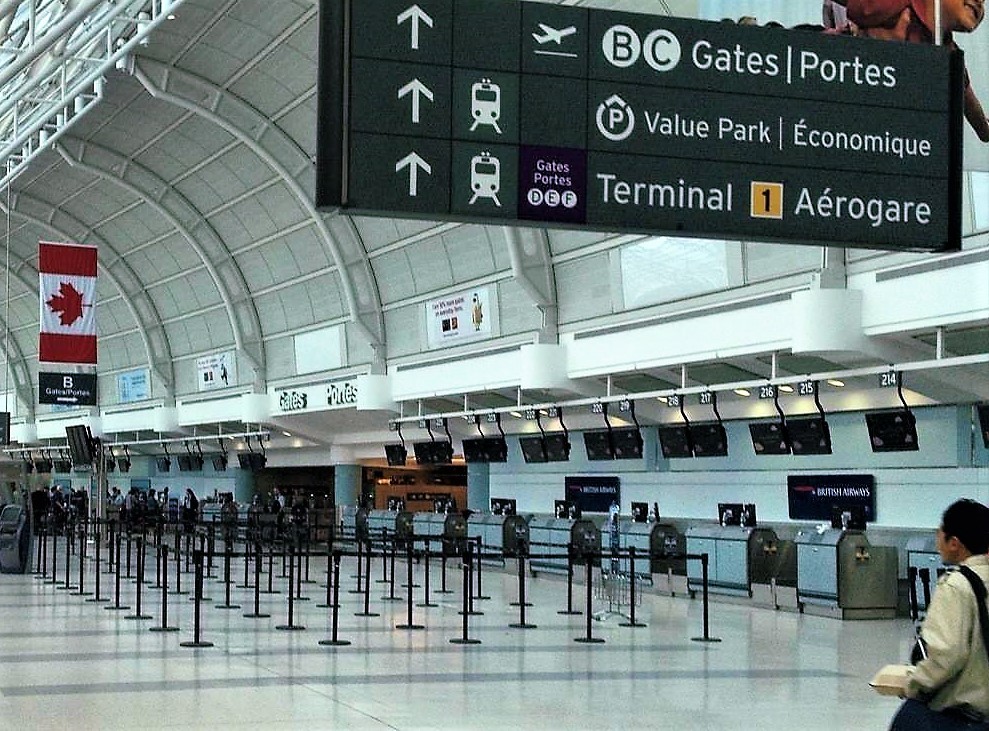
Passenger volumes at Pearson Airport have fallen by 96 percent
In a rather complex relationship, Pearson, which is owned by Transport Canada (the federal government), is actually operated through a leasing arrangement governed by a federal Act, and the Greater Toronto Airports Authority is the non-profit organization that runs it. But it negotiates assessments and payments for its property with the provincial government.
Legislation that dates back to 2001 means, instead of paying property tax to the City of Mississauga for the land it occupies, the airport pays a few cents for every passenger that passes through its two terminals. The arrangement makes Pearson’s success Mississauga’s and guarantees their pain is shared. At least that’s how it’s meant to work.
A series of caveats in the legislation, known as Payment in Lieu of Taxes or PILTs, mean that no matter what happens, the city gets a raw deal. For the years the airport does well, an increase-cap of 5 percent is applied to its payments, limiting how much Mississauga can share in its success. A year of 7 percent passenger growth would only see PILTs grow 5 percent, the same is true of a 10 percent spike or even 15.
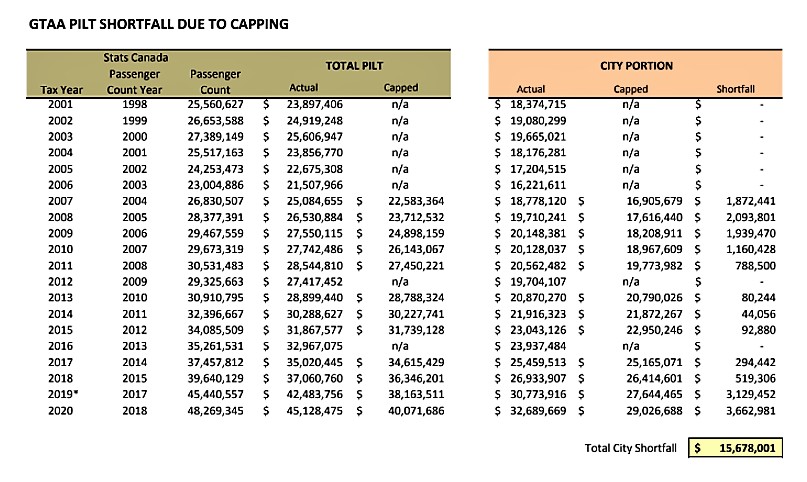
Mississauga, pre-pandemic, was already more than $15M in the hole because of Pearson Airport, but that number will balloon for years because of the huge loss of passengers
To make the system harsher still, the cap is not applied on the way down. If the airport has a bad year, there is absolutely no limit to how low its PILTs can fall. From that new low, wherever it may be, the city is then limited to growth in increments of 5 percent.
So, revenues to city hall are limited despite massive gains by Pearson, but can fall off a cliff and then only climb back up slowly, even if the airport’s revenues go back to flying skyhigh right away.
PILTs are paid on a two year delay, with the city receiving payment for 2018’s passengers in 2020. Like an anvil waiting to fall, passenger volumes at the airport this year will be reflected in payments made by the airport in 2022.
Travel bans as a result of COVID-19 and the devastating impact of the novel coronavirus on air travel serve as an example of just how damaging the current relationship between the airport and city can be.
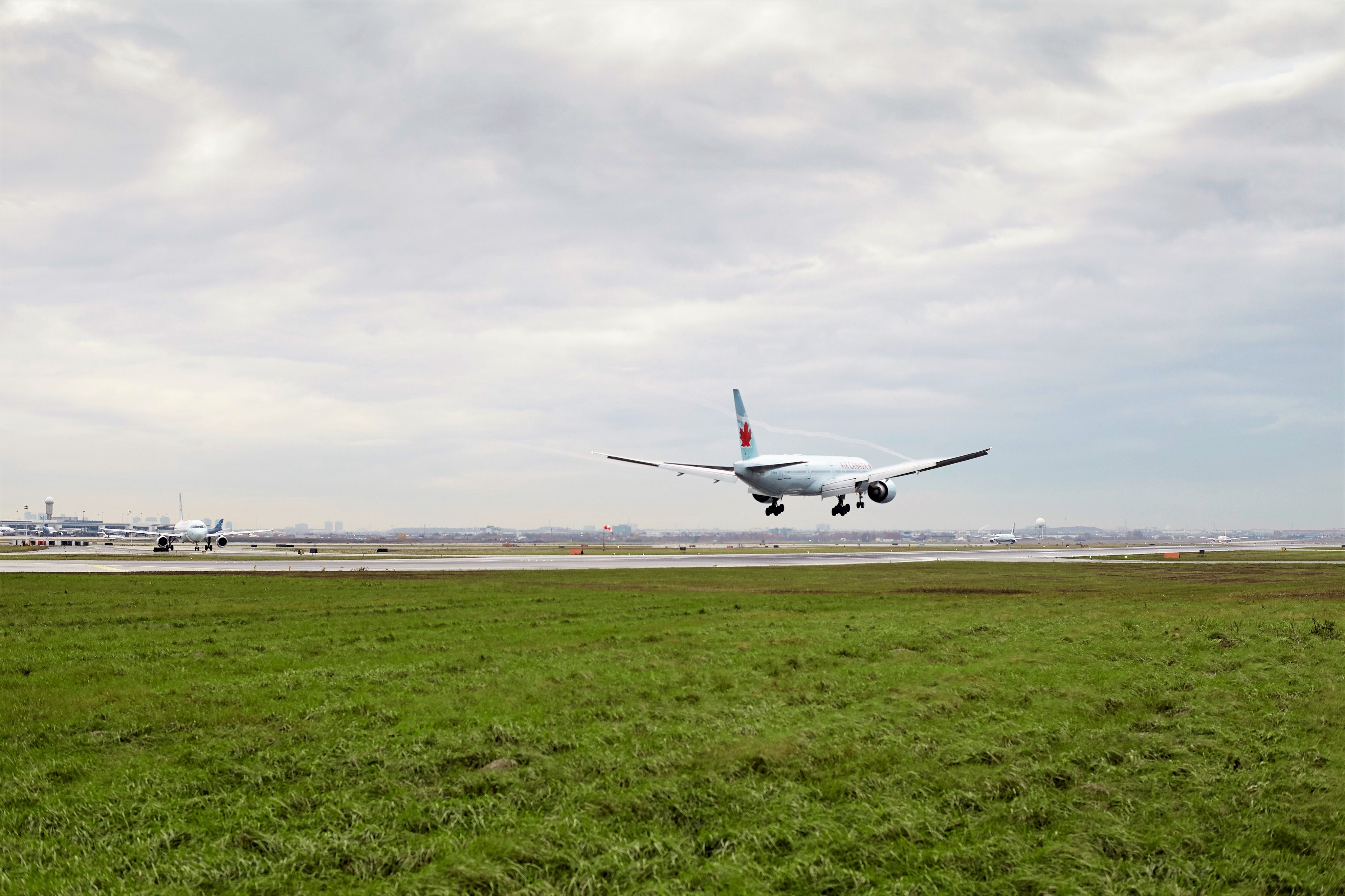
Before the virus struck, Toronto Pearson Airport saw roughly 130,000 passengers pass through its doors each day. On average, 1,300 flights took place daily operated by 67 different airlines. Robin Smith, a spokesperson for the Greater Toronto Airport Authority, said those numbers have dropped “significantly” since the pandemic began.
Passenger volume is down 96 percent to 5,000 each day, while the number of flights has plummeted 73 percent to 350 every day. The number of airlines operating on Pearson’s tarmac is down 86 percent to just 9.
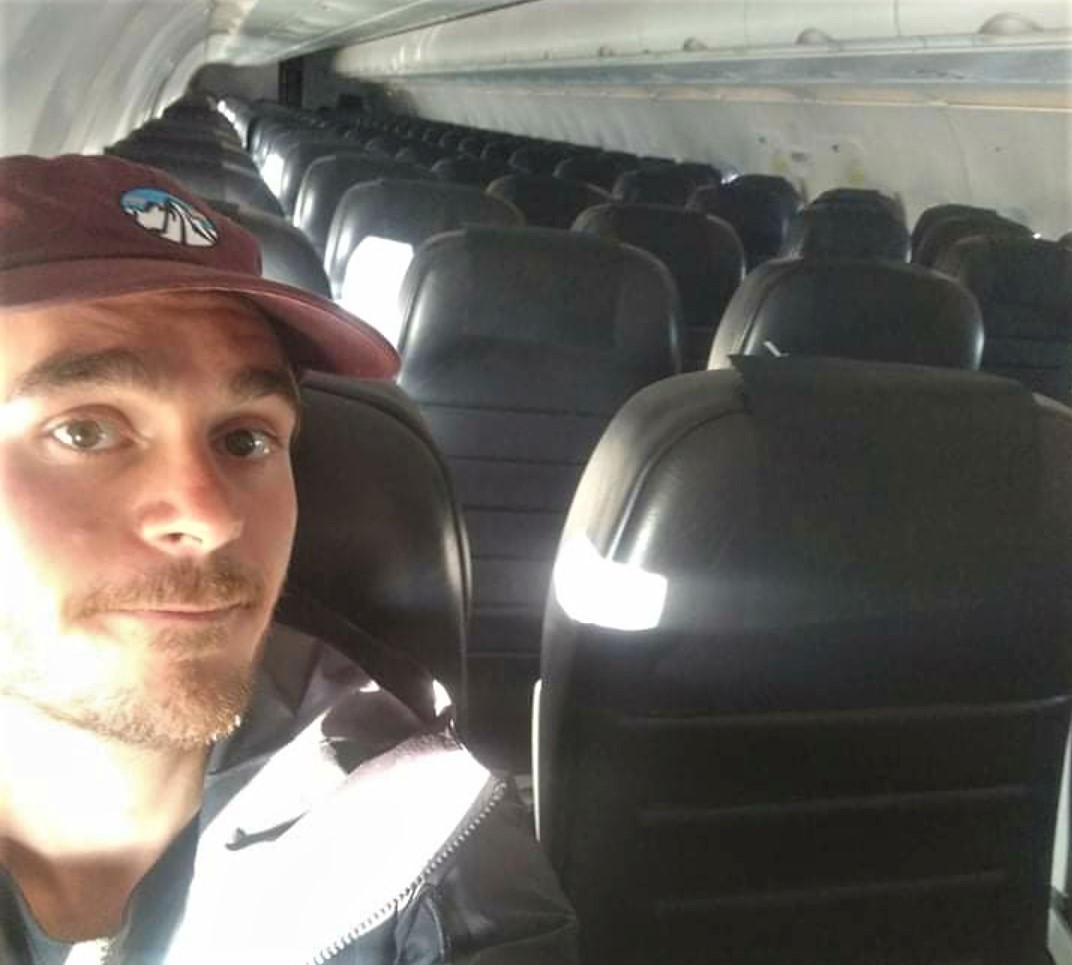
Brampton native Atticus Whitfield, flew home on a near-empty plane from New Zealand at the beginning of the pandemic
Even before the crisis, PILTs dealt Mississauga a rough hand; what it threatens to do to the city now is staggering. A calculation by staff at the City of Mississauga demonstrating the 5 percent cap and how much the city would have received without it shows, since 2001, capping has cost them $15.7 million. As passenger numbers surged in 2017 and 2018, for example, the city lost out on $3.1 million and $3.6 million respectively.
A crude calculation based on current numbers shows how COVID-19 could make this significantly worse. In 2020, Mississauga received $29 million ($32.6 million if there was no cap) for passenger volumes in 2018.
Take the capped payment of $29 million for 2018 as an example and combine it with the airport’s current losses. Pearson’s 96 percent drop in passengers would see PILTs drop $27.8 million and leave the city with as little as $1.2 million. The five percent cap would mean that number could only climb to $1.26 million the next year and to $1.32 after that.
These numbers are only an illustration, of course; 2019’s number, when it is paid next year, will be roughly 5 percent higher than 2018’s meaning PILTs will fall from a higher height and passenger volume throughout 2020 may not drop as much as 96 percent. Regardless, the fall will be severe.
None of this is news to the staff or councillors in Mississauga. The city has been fighting to have the system changed in some form almost since its inception in 2001. “I think it’s been in every pre-budget submission and [an issue at] every provincial election,” Mississauga’s Commissioner of Corporate Services and Chief Financial Officer, Gary Kent, told The Pointer. “Because of the cap, we suffer the pain when [passenger volume] goes down and we’re comfortable doing that. We will suffer that pain when it’s bad, but when it zooms back up again [and] we can [only] catch up 5 percent a year — that’s punitive. All we’re saying is get rid of the 5 percent, it is a historical legacy.”
Most recently, Mayor Bonnie Crombie wrote to the province in February reiterating the city’s ask. The issue had been raised at the Association of Municipalities of Ontario conference in 2019 and countless times before.
“Keeping in line with your government’s objective to modernize government and ensure fairness for Ontario taxpayers, I would ask that the PIL[T] cap be removed to ensure fairness and equity between the GTAA and commercial taxpayers in Mississauga,” Crombie wrote.
Crombie’s letter to the Progressive Conservative administration must have been bittersweet to write. After years of wrangling and lobbying with the previous Liberal government, the City had made a breakthrough. A few lines in the 2018 Ontario Budget offered vague optimism to City Hall and a chance to finally right a wrong that had irked local officials and hurt city coffers for almost two decades.
“To ensure that municipalities with airports and the authorities that operate them are treated fairly, the province is planning to conduct a review of the current approach used to calculate payments in lieu of property tax (PILT),” the Liberal budget document proclaimed two years ago. “The passenger rates used to calculate the PILT have not changed since they were introduced in 2001. The review of the PILT program will include consultation with affected municipalities and airport authorities.”
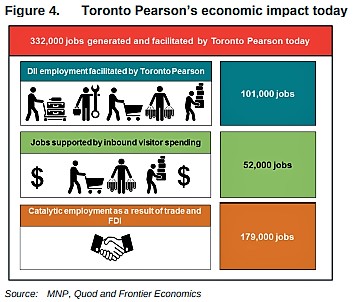
The GTAA, which runs Pearson, argues that it is a huge economic engine for the region
The Liberals told the city it may be difficult to overturn the legislation completely and make airports pay property tax at the same commercial rate as everyone else, but they said the rates could be changed. Ward 5 Councillor Carolyn Parrish, who represents the area that includes Pearson, was heavily involved in lobbying the Liberals. She said it had been indicated the City’s efforts looked to be successful and the 5 percent cap was likely going to be scrapped. But that was before the Liberals were defeated in 2018.
Across Ontario, different rates apply to different airports. London pays $1.67 per passenger, Ottawa $1.08, Thunder Bay $0.55 and Pearson $0.94. Changes to those rates were central to what the Liberal review proposed to investigate.
There was hope at City Hall, but just a few months later, Doug Ford and the PCs swept to a thumping victory at Queen’s Park and reduced the Liberals to just six seats; 2019’s budget document bore no reference to PILTs and it was back to square one.
A spokesperson for the province says that though the current arrangement has been in place since 2001, the pandemic leaves open the possibility of making changes.
“We recognize the current circumstances may present new challenges for both airports and their host municipalities in 2022,” Scott Blodgett, spokesperson for the Ontario Ministry of Finance, told The Pointer. “We would encourage the City and Airport Authority to discuss their concerns regarding the PILT system and we would welcome their advice on approaches that could better address the current circumstances.”
Meanwhile, the ongoing pandemic means without a new agreement local taxpayers will essentially subsidize the airport for years due to the flawed nature of the payment scheme and the dramatic drop in revenue.
Unsurprisingly, the Greater Toronto Airports Authority, which runs Pearson, does not take the same view as the City.
“As you are aware, Ontario’s Airports are facing an unprecedented challenge due to COVID-19,” a spokesperson for the airport said. “Passenger travel is the primary revenue stream for airports, and that has effectively been eliminated as passengers travelling through the airport in April 2020 dropped by approximately 98 per cent over the same period of 2019. This has caused significant cash flow issues and recovery is expected to take years. These payments will be very challenging for the GTAA in light of the impacts of COVID on Toronto Pearson and the entire aviation sector.”
Many in the Pearson community have traditionally pointed to the airport’s huge economic footprint as justification for its low contributions to municipal coffers, pointing out that massive commercial spin-offs add to the generation of $42 billion into the economy.
As that argument goes, the airport is the city’s economic driver. The airport zone in Mississauga is the second largest collection of jobs in the entire country, only behind downtown Toronto.
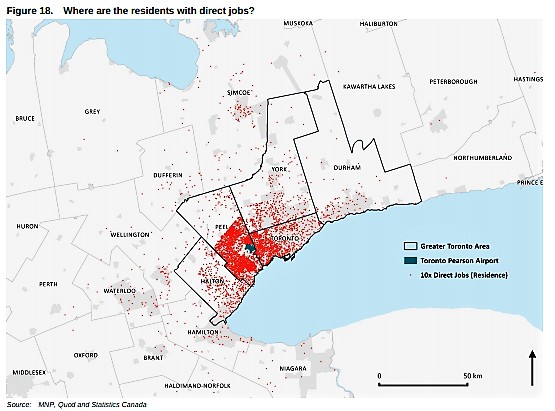
The map above shows Peel Region residents make up the largest portion of Pearson Airport-related employment
According to research commissioned by Pearson in 2016, the airport generates 332,000 jobs. The research shows the airport, as a key economic driver, has experienced “twice the growth of Toronto” and “five times the rate of Ontario” between 2012 and 2016. During that time line jobs at Pearson grew 22 percent, compared to 9 percent in Toronto or 4 percent for the province as a whole.
Projections by the airport suggest it will handle 63 million passengers by 2030 and facilitate 542,000 jobs.
The justification is fairly simple: Pearson puts Mississauga on the map, creates thousands of jobs and offers unparalleled economic stimulus.
However, it omits an inconvenient fact. While economic development is critical to the city in the long-term and important for marking out from the crowd, the jobs that the airport generates pay their taxes to other levels of government and not the City. And the spin-off businesses that pay commercial property taxes, receive in return all the services and infrastructure paid for by Mississauga taxpayers.
The city’s roads are worn down by freight trucks, Peel Region’s paramedics are called to help passengers at the airport and MiWay buses (53 percent subsidized by the city) connect passengers and employees.
There is some hope that the COVID-19 pandemic will provide an opportunity to finally fix the discrepancy that sees Mississauga taxpayers paying an outsized amount to support Pearson.
The $3 million plus lost in 2020 and 2019 due to capping is no small amount for the city, but is perhaps viewed as bean counting by the province. The revenues Mississauga could lose in 2022 and beyond as a result of the virus, on the other hand, is nothing short of eye watering.
“Sometimes you need a real shocker of a number like this to say ‘Oops, maybe this is a good time to look at this’,” Parrish, who led the charge on PILTs before the 2018 election, told The Pointer. “We need the money to maintain the roads, to maintain the traffic control. The GTAA generates thousands of jobs, but that income tax goes to the feds and the province. What it is generating for us [at the city] is a lot of work and a lot of cost and we should be able to get that back.”
Email: [email protected]
Twitter: @isaaccallan
Tel: 647 561-4879
COVID-19 is impacting all Canadians. At a time when vital public information is needed by everyone, The Pointer has taken down our paywall on all stories relating to the pandemic to ensure every resident of Brampton and Mississauga has access to the facts. For those who are able, we encourage you to consider a subscription. This will help us report on important public interest issues the community needs to know about now more than ever. You can register for a 30-day free trial HERE. Thereafter, The Pointer will charge $10 a month and you can cancel any time right on the website. Thank you.
Submit a correction about this story


